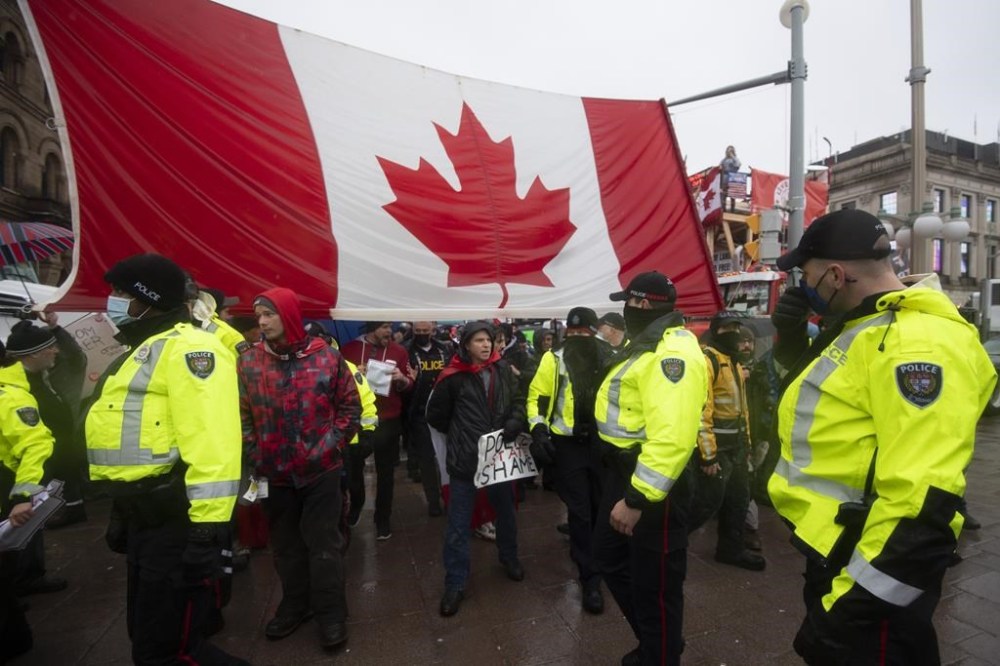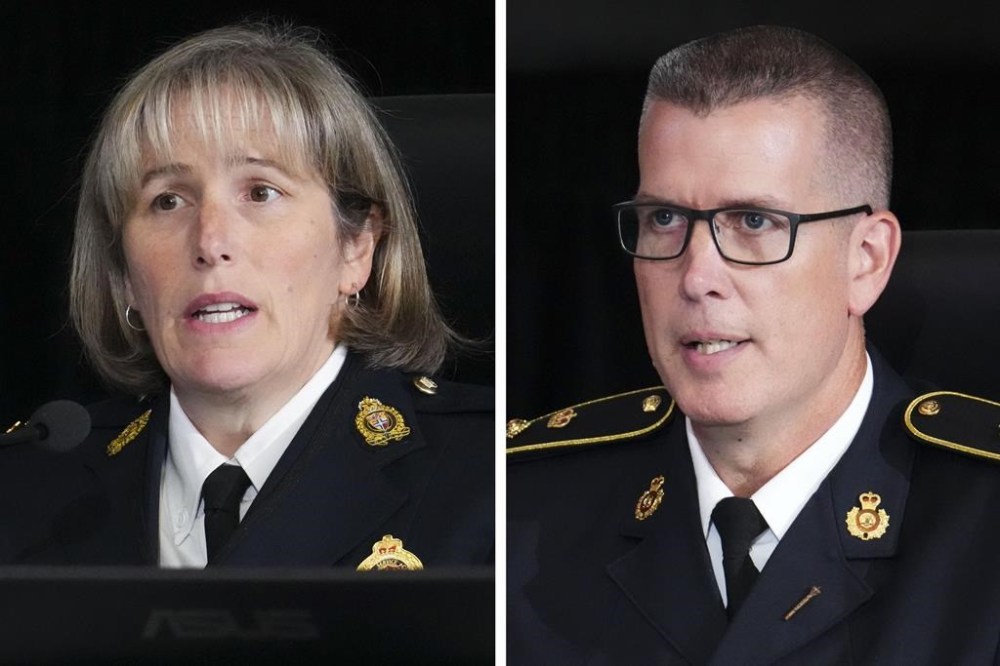‘There was no plan’ officers slam Ottawa police handling of ‘Freedom Convoy’
Advertisement
Read this article for free:
or
Already have an account? Log in here »
To continue reading, please subscribe:
Monthly Digital Subscription
$0 for the first 4 weeks*
- Enjoy unlimited reading on winnipegfreepress.com
- Read the E-Edition, our digital replica newspaper
- Access News Break, our award-winning app
- Play interactive puzzles
*No charge for 4 weeks then price increases to the regular rate of $19.00 plus GST every four weeks. Offer available to new and qualified returning subscribers only. Cancel any time.
Monthly Digital Subscription
$4.75/week*
- Enjoy unlimited reading on winnipegfreepress.com
- Read the E-Edition, our digital replica newspaper
- Access News Break, our award-winning app
- Play interactive puzzles
*Billed as $19 plus GST every four weeks. Cancel any time.
To continue reading, please subscribe:
Add Free Press access to your Brandon Sun subscription for only an additional
$1 for the first 4 weeks*
*Your next subscription payment will increase by $1.00 and you will be charged $16.99 plus GST for four weeks. After four weeks, your payment will increase to $23.99 plus GST every four weeks.
Read unlimited articles for free today:
or
Already have an account? Log in here »
Hey there, time traveller!
This article was published 20/10/2022 (1148 days ago), so information in it may no longer be current.
OTTAWA – The “Freedom Convoy” had gridlocked Canada’s capital city for more than two weeks before the “floundering” Ottawa police force approved a detailed plan to handle it, senior police officers have told the public inquiry into the Liberal government’s use of the Emergencies Act.
Patricia Ferguson, the acting deputy chief of the Ottawa police, said Thursday that the force assumed protesters would not stay longer than a weekend and relied at first on a boilerplate plan that had been used for other downtown events involving big crowds, such as Canada Day celebrations.
In hindsight, Ferguson said she would have given more credibility to early warnings from the Ontario Provincial Police and other intelligence suggesting the group planned to stay for weeks.

Police knew about those warnings, but they weighed it against other intelligence and moved ahead with their standard events plan, she said.
The only contingency plan focused entirely on bringing in some extra officers for the weekend and there was nothing in place to deal with the possibility that protesters would stick around.
It wasn’t until Sunday evening, whennearly 700 trucks were still on the streets, that police began to realize their mistake.
“We had been talking about a demobilization plan up until that point, and clearly that was not the plan that was going to be required,” Ferguson told the Public Order Emergency Commission, which is scheduled to hold public hearings in downtown Ottawa through to Nov. 25..
With no officers focused only on planning at that point, “I think we were floundering a little bit,” she said.
“I would describe us as being on our knees and having run a marathon for the last two and a half years, and it felt like they’d moved the finish line 100 yards … and given us 200 pounds to carry to get to the end,” she said.
“Staffing was, I would say, our number 1 Achilles heel in all of this.”
Justice Paul Rouleau, who is leading the commission, asked Ferguson if there was any contingency that involved allowing the protest to continue lawfully.
“I don’t know if those conversations were happening,” she replied.
Ontario Provincial Police Supt. Craig Abrams told the commission his officers found dysfunction in the ranks of Ottawa police from the early days of the protest.
On the first weekend, OPP Insp. Dawn Ferguson told Abrams she had a meeting with local police officials who were yelling and swearing.
“They clearly, it seemed to her, had lost some control over what was occurring and didn’t have a way to figure it out,” Abrams said.
On Feb. 2, the provincial police questioned why Ottawa police were asking for more officers without specifying what they wanted those officers to do.
Ferguson said a certain level of lawlessness had set in around downtown Ottawa by then, and police were so stretched that they weren’t able to investigate every serious incident that was reported to them.
Ferguson said Ottawa’s police chief at the time, Peter Sloly, started directing operations outside of the chain of command.
He asked for a plan focused on public order, which would typically be developed alongside strategies to deal with traffic and other elements, she said. That public-order plan never materialized.
Abrams said it was difficult to anticipate what help the Ottawa Police Service needed.
“We couldn’t read their mind as to what their plan was, because there was no plan,” he said.

On Feb. 4, Abrams formally raised that issue with then-Deputy Chief Steve Bell, telling him the service was “disorganized and poorly co-ordinated.”
Two days later, Abrams said he was part of a call where Sloly told his staff he would ask for double the number of officers they needed. When Sloly made a request for 1,800 officers the next day, Abrams said he “viewed it with suspicion.”
Ferguson said a realplan was outlined on paper on Feb. 9, more than a week after the protesters arrived.
She told the commission she had arguments with the chief about the aggressive nature of what was put forward, and advocated for negotiating with protesters.
Sloly said in a meeting that he would “crush” anyone who undermined that plan, according to notes taken by Ferguson, who told the commission she was “aghast” at the comment.
A team called the “integrated planning cell,” which included the RCMP, OPP and subject matter experts from other police services, wrote scathing assessment of the police response up to that point.
The report described the response as of Feb. 10 as reactive, tactical, aggressive and risky, and “not intelligence led.”
The planning group suggested Ottawa police were focused on maintenance, not on resolving the protest, which Ferguson said was because of the number of officers available.
In an earlier interview with the commission, Ferguson said Sloly “may have been distrustful” of the planning team because he knew some of the people on it, including former Toronto police chief and Emergency Preparedness Minister Bill Blair.
The 73-page plan that was eventually approved on Feb. 13 was still not complete.
The version submitted to the inquiry as evidence shows the internal and external communications strategy was still being developed, and contingency plans had not yet been obtained from specialized units, including one designed to deal with explosives.
The plan acknowledged “mass arrests may be the only potential outcome” but sought alternative means for making arrests, including doing them “off-site and discreet” or through a summons.
Ferguson told the commission that the invocation of the Emergencies Act on Feb. 14 “greased the wheels” of that plan, which culminated in police beginning to clear protesters from the streets on Feb. 18 with the help of more than 2,000 extra officers.
This report by The Canadian Press was first published Oct. 20, 2022.


